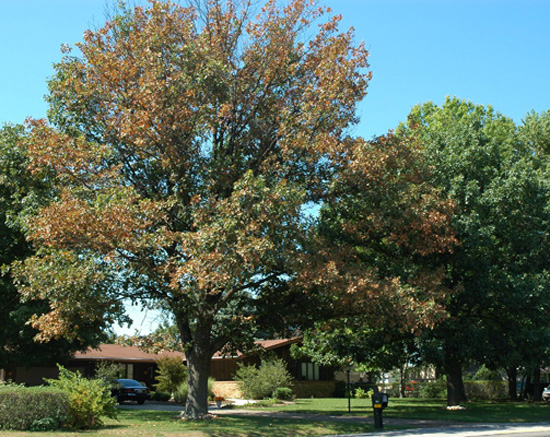Issue 13, July 30, 2010
Bacterial Leaf Scorch Treatment
For many years I have been advocating testing of oaks for bacterial leaf scorch (BLS). This disease is a silent killer of sorts. It is caused by a bacterium, Xyllela fastidiosa, which lives only in the xylem tissues. Symptoms begin as leaf scorch. Scorching becomes progressively worse over a period of 3 to 8 years or so, eventually resulting in tree death. Often the true cause of the disease is not discovered until tree decline is quite advanced. I have seen this happen to several mature pin oak trees in Champaign and Urbana. Other species are also susceptible, but our lab has only confirmed it on oaks. I have described this disease in past articles of this newsletter, most recently issue #14 in 2009.

John Hartman and Ed Dixon of the University of Kentucky, with Shawn Bernick of Rainbow Treecare Scientific Advancements, recently published an Evaluation of Therapeutic Treatments to Manage Oak Bacterial Leaf Scorch. This article appears in the online journal, Arboriculture & Urban Forestry, Volume 36, May 2010. Treatments were applied to infected pin oaks over a period of five years. The article discusses treatment options and results. The authors also discuss other options for extending the life of infected trees.
No cure of this disease has been found. In fact, nothing works to cure an infected tree. Still, this study concluded that therapeutic treatments (those applied to infected trees) may help prolong tree life. For some of our clients, even prolonging tree life is desired over loss of the tree. Treatments used in this study included root flare soil drenches of paclobutrazol, basal trunk applications of anti-microbial compounds, and spring applied root flare injections of oxytetracycline. If you are considering therapeutic treatments of oaks with BLS, read this article for detailed analyses of treatments. Some take home points to consider if using oxytetracycline root flare injections are that spring injections reduced scorch levels and delayed summertime scorch symptom appearance by a couple of weeks. Additionally, injections done three weeks after full leaf expansion of first leaves seemed to be better than other springtime applications. Hopefully you will find time to read this journal article before doing BLS treatments.--Nancy Pataky
Author:
Nancy Pataky